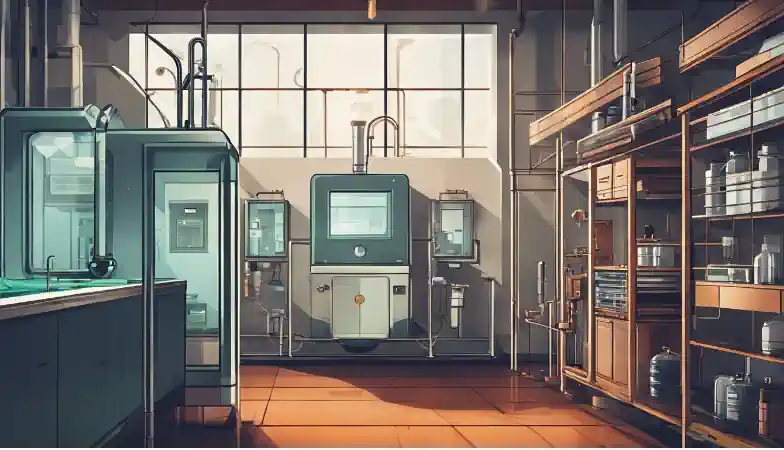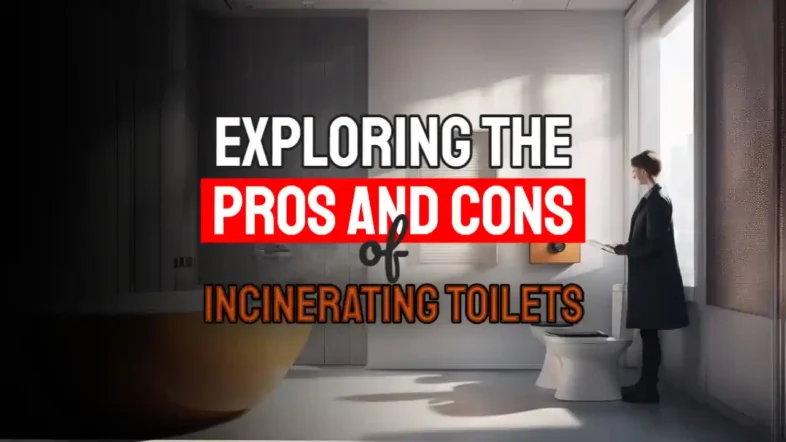Finding the right waste management solution can be tricky. Want to know the incinerating toilets pros and cons? Incinerating toilets turn waste into ash using high heat. This article will guide you through their benefits and drawbacks to help you decide if they're a good fit for your needs.
Keep reading, it's interesting!
Key Takeaways
- Incinerating toilets turn human waste into ash using high heat, which saves a lot of water. They are good for places without access to water or sewage systems.
- These toilets need a lot of energy to work, whether they use electricity or gas. This can make your bills higher and affect the environment.
- You have to clean incinerating toilets regularly and check their venting systems once a year to avoid bad smells.
- While they save water and reduce waste, incinerating toilets require more space because of the ash storage and exhaust system needs.
- Choosing between incinerating toilets and other options like bio – toilets depends on your situation, including where you live, your budget, and how much you want to help the environment.

Understanding Incinerating Toilets

Incinerating toilets turn human waste into ash using heat. They come in two types: one uses electricity, and the other uses gas like propane.
How Electric Incinerating Toilets Work
Electric incinerating toilets turn human waste into ash using high heat. They need electricity or a gas supply to work. First, you use the toilet normally. Then, with a push of a button, the electric element inside heats up to 970-1400°F.
This process burns everything in the bowl, turning solids and liquids into a small amount of sterile ash.
The whole burning takes one to three hours. After that, only a tiny bit of ash stays behind. You must empty this ash container every few weeks, depending on how often you use the toilet.
The system also needs an exhaust pipe for smoke and smells during the burning process. Annual checks keep the venting system working right and make sure everything stays clean and safe.
How Gas-Powered or Electric Incinerating Toilets Function
Gas-powered incinerating toilets use propane or natural gas to transform human waste into ash. They work by heating the waste at extreme temperatures, between 970 and 1400°F. This process requires a source of power, which can alternatively come from solar panels or any electrical service available on on-grid properties.
These types of toilets are suitable for places without access to water services, making them ideal for remote locations.
The operation starts with placing the waste into a combustion chamber. Once the toilet is used, it seals the waste before igniting it with gas. The high heat breaks down the biological matter completely, leaving behind a small quantity of sterile ash.
This method not only provides an effective way to dispose of human waste but also meets high hygiene standards by eliminating pathogens and odours without using water or creating sewage.
Comparing Incinerating Toilets with Bio-Toilets

To make an informed choice between incinerating toilets and bio-toilets, it's essential to understand how they stack up against each other. Here's a straightforward comparison to help you grasp the basics and the impacts of each type on waste management and environmental sustainability.

Table of incinerating toilets pros and cons
| Aspect | Incinerating Toilets | Bio-Toilets |
|---|---|---|
| Operation Method | Use high heat to turn waste into ash. | Use natural biological processes to turn waste into biogas and compost. |
| Energy Use | High, due to the need for electricity or gas to dry and incinerate this high water-content waste. | Low, mostly requires natural processes; some models might use a minimal amount of energy for ventilation. |
| Water Use | Minimal, as no flushing is required. | Varies, but generally low since they often use a closed-loop system. |
| Waste Product | Ash, which is sterile and lightweight. | Biogas, which can be used for cooking or heating, and compost for gardening. |
| Installation Cost | High upfront costs due to technology and construction materials. | Generally lower, but varies based on the system size and complexity. |
| Maintenance | Requires regular emptying of ash and maintenance of electrical or gas components. | Needs periodic removal of compost and, occasionally, biogas system checks. |
| Environmental Impact | Low water use, but high energy consumption will contribute to carbon footprint unless you use a renewable energy source. | In some types, may produce renewable energy. However, the compost reduces waste volume and enriches soil quality. |
From firsthand experience, choosing the incinerating toilets pros and cons between an incinerating toilet and a bio-toilet depends much on your situation.
If you're in a region with scarce water resources, an incinerating toilet might seem appealing due to its minimal water use. On the other hand, if sustainable living and renewable energy are your goals, a bio-toilet provides an excellent opportunity to turn waste into resources like biogas and compost.
Next, let's delve into the pros of incinerating toilets to determine why they might be the right choice for your needs.
Pros of Incinerating Toilets
Incinerating toilets turn waste into ash, helping to save a lot of water. They also keep things very clean, which cuts down on the spread of germs.
Water Conservation
Water saving is a big win with incinerating toilets. These loo options use zero water, so they save 100% on what a traditional flushing toilet would use. This is especially helpful in dry areas or places without easy access to water services.
By turning waste into ash, these systems get rid of the need for water.
My first experience with an incinerating toilet was eye-opening. At a remote cabin without running water, the choice was clear: bring gallons of water for a standard toilet, take care to look after a bio-toilet, or go with a less eco-friendly option that burns waste.
We chose the latter with a propane cylinder as the gas source and we were amazed at how it provides convenience and cleanliness in an off-grid setting. This is a valuable considering among the other incinerating toilets pros and cons .

Efficient Waste Disposal
Incinerating bathrooms turn human waste into a tiny amount of ash. This process slashes the need for storing, moving, or getting rid of waste in other ways. Since these toilets produce less rubbish, disposal becomes more straightforward and less bulky.
It means cities and homes can manage waste better without the otherwise heavy load on sewage systems.
The savings can be crucial in areas where water is scarce or costly. By turning waste into ash quickly, incinerating loos offer a smart solution to tackle rubbish without using loads of water or creating lots of pollution.
High Hygiene Standards
Moving on from efficient waste disposal, it's vital to highlight the role of incinerating toilets in maintaining cleanliness. These units ensure a high degree of hygiene by reducing the risk of bacteria spread and contamination—key concerns in traditional water-based systems.
These toilets operate without needing water or drainage, which cuts down on bacterial growth significantly. This process is not only swift but also leaves no odour behind, making them an ideal choice for those prioritising a clean and sanitary environment. Bear this in mind when considering the numerous incinerating toilets pros and cons
For upkeep, owners must regularly clean the bowl and ash receptacle. As we have already stated, they should also clear out the exhaust pipe and venting system once a year. This routine makes sure that the high standards of hygiene are upheld over time.
From my experience using one in a remote cabin setting, I found this maintenance quite straightforward — it certainly beats dealing with clogs or leaks common in flush toilets!
Cons of Incinerating Toilets
While incinerating toilets bring several benefits, they also have downsides like using a lot of energy and needing more room. So, incinerating toilets pros and cons need careful thought before making a decision. Keep reading to find out how these aspects might influence your choice.
High Energy Consumption
Incinerating toilets use a lot of power. Even gas-powered models need electricity for their fans. This is a big deal because it means they're always using energy, not just when you flush.
From my own experience, I've seen the electricity bills go up after installing one at home. It's something people should think about before getting an incinerator.
These toilets are great for saving water and keeping things clean, but they're hungry for energy. Whether it's solar power or propane gas, running these units costs more than you might expect.
And with concerns about emissions and being kind to the environment, it’s important to consider how much power they use. There's a balance to be struck between hygiene and saving energy.
Noise Levels
Incinerating toilets bring many benefits, but they are not silent. The sound comes from fans and the combustion process. These noises might surprise users at first. In my experience, the fan's hum is constant while the toilet runs.
This noise level can vary depending on where you install it in your home.
Having one in a camper or portable outhouse changes how you hear these sounds. Inside a small space, like a caravan, noises seem louder. The sound of burning waste and running fans becomes part of the background when using the toilet indoors.
Over time, most people get used to these sounds. It's much like living near a busy road; eventually, you notice it less and less. It is a personal preference to be weighed up among all the other incinerating toilets pros and cons.

Space Requirements
Space plays a crucial role in setting up incinerating toilets. You need room for the toilet itself and an area to store the ash safely. My own experience showed me that planning is key.
Every part, from the bowl to the container for the leftover ash, needs space.
The exhaust system also demands attention. It includes pipes and vents that help remove smoke and odours. These parts require access for yearly cleaning to keep everything running smoothly.
This means leaving space around them free from clutter—something I learned when fitting one into my small workshop restroom.
Maintenance Requirements of Incinerating Toilets
Incinerating toilets turn waste into ash. They need regular upkeep to work well. Clean the bowl and ash pan often. Every year, you must also clean out the exhaust pipe and airing system.
These tasks stop bad smells and keep the toilet running smoothly.
These toilets require power to operate effectively, even gas models use electricity for their fans. Regular checks ensure they function properly without issues, keeping them environment-friendly and efficient in managing human waste.
Choosing Between Incinerating Toilets and Other Options
Deciding on incinerating toilets or exploring other methods like compost lavatories is crucial. Think about your budget, environmental impact, and what's most practical for you.
Cost Factors
Choosing between incinerating toilets and other options involves thinking about money. Incinerating toilets save water and plumbing costs because they do not need them. This is great for places without easy access to water or sewage systems.
Yet, they use a lot of power or gas. Electric models add to your electricity bill. Gas models need natural gas or propane, which also costs money.
Incinerating toilets help cut down on waste management costs. There's no need for handling, moving, or getting rid of human waste. This makes them useful in remote areas where traditional sewage isn't an option.
It also means less damage to the environment from pollution related to common sewers and septic systems. Think about these factors before making your choice.
Environmental Considerations
Considering the environment, incinerating toilets offer a unique advantage by conserving water. Unlike traditional or compost loo options that rely on significant amounts of water or proper decomposition, these units transform waste into ash without using a single drop.
This feature is crucial for areas facing water scarcity and efforts towards green energy initiatives. The process also cuts down the risk of contaminating natural water bodies, supporting cleaner habitats and reducing health hazards linked to poor sanitation.
Yet, operating at temperatures between 970-1400°F means consuming a lot of energy, whether electric or gas-powered. This high-energy demand can increase carbon emissions, especially if the power comes from non-renewable energy sources.
Switching to renewable sources like solar power could mitigate these impacts, aligning with sustainable waste management practices and clean cooking concepts. Next up: Future prospects for incinerating human waste take centre stage as we weigh its viability against emerging technologies and environmental needs.
Convenience Aspects of Incinerating Toilets (Pros And Cons)
Choosing between incinerating toilets and other options hinges on ease of use. Incinerating toilets bring a big plus for locations without water or sewage connections. They need no plumbing or water, making them easy to install in even remote areas.
Yet, their reliance on gas or electricity means one must have access to these resources. This makes them less ideal for places off the grid unless coupled with solar panels or generators.
Future of Incinerating Human Waste
The future of incinerating human waste looks mixed. On one side, these toilets save a lot of water and keep things clean, making them great for places without easy access to water or in public restrooms that need to stay sanitary—as long as their downtime during incineration does not prevent heavy usage.
They turn waste into ash, cutting down the risk of diseases spreading. But, they need a lot of power and upfront cash which makes some people think twice. I have seen how effective they can be in areas where other options just won't work.
Innovation could change the game though. Scientists and engineers are working on new ways to make these toilets use less energy and cost less money. Imagine a world where every home biogas system or dry toilet not only recycles waste but also produces energy with little to no effort from us – it's a direction worth exploring for everyone interested in living green and reducing their impact on the planet.
These changes might make incinerating toilets more common around the world, especially as we all look for ways to be more environmentally friendly while dealing with our daily needs.
Incinerating Toilets Pros And Cons – Conclusion
Exploring incinerating toilets brings up a mix of good and bad points. They help save water and keep things clean, but they use a lot of power and make some noise. Choosing between them and other types like compost loos depends on what you value more—things like cost, helping the environment, or ease of use.
As we look ahead, these fiery loos offer an interesting way to deal with waste while cutting down on water use. Deciding if they're right for you means weighing up their benefits against their drawbacks carefully.

Incinerating Toilets Pros And Cons FAQs
1. What are the main advantages of using incinerating toilets?
Well, incinerating toilets offer a handful of benefits – they're brilliant for saving water, reducing household air pollution, and turning waste into ash without the need for traditional plumbing or a compost bin. Plus, you won't have to worry about defecating in the open.
2. Are there any downsides to incinerating toilets?
Indeed, there are a few cons to consider. For starters, they require electricity or gas to run – which means fire risk and possible particle emissions during use. Also, the initial cost might be higher than your standard or compost toilet.
3. How do incinerating toilets compare with composting ones?
Ah, good question! Incinerating toilets burn waste immediately and leave behind ash; this process is quite fast but needs energy. Compost toilets break down waste over time through anaerobic digestion into organic fertiliser but require more manual handling and space for a compost bin.
4. Can incinerating toilets really save water?
Absolutely! These dry toilets don’t use water for flushing like traditional models do – making them an excellent option in areas where water consumption is a concern or when trying to cut down on utility bills.
5. Do I need regular inspections with an incinerating toilet?
Yes – while maintenance might be less frequent than with other types of systems, it's still important to ensure everything's working correctly and safely, especially given that fire is involved in their operation.




